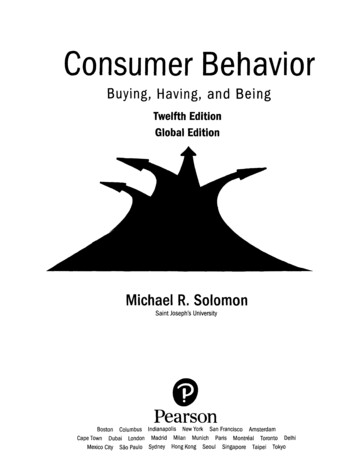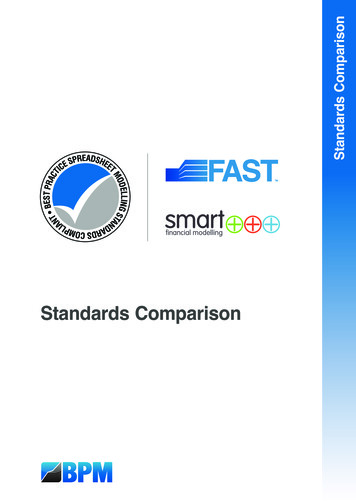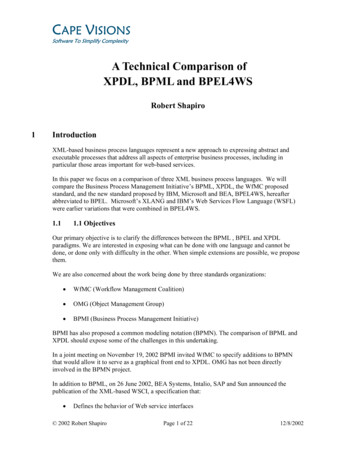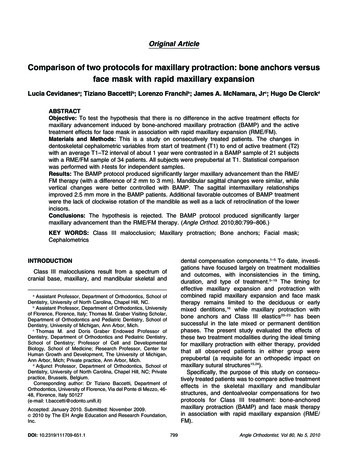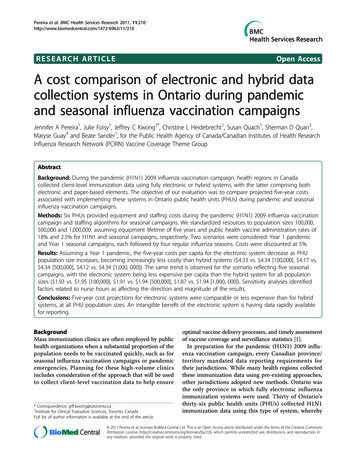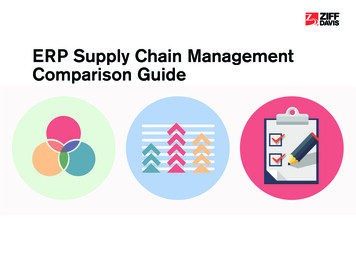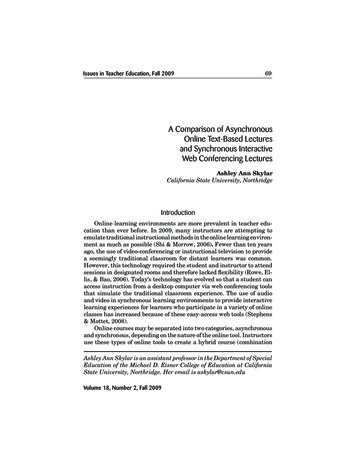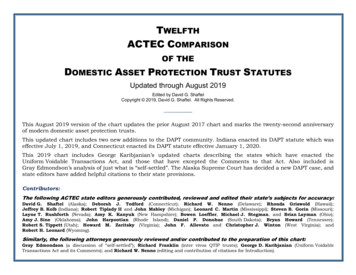
Transcription
TWELFTHACTEC COMPARISONOF THEDOMESTIC ASSET PROTECTION TRUST STATUTESUpdated through August 2019Edited by David G. ShaftelCopyright 2019, David G. Shaftel. All Rights Reserved.This August 2019 version of the chart updates the prior August 2017 chart and marks the twenty-second anniversaryof modern domestic asset protection trusts.This updated chart includes two new additions to the DAPT community. Indiana enacted its DAPT statute which waseffective July 1, 2019, and Connecticut enacted its DAPT statute effective January 1, 2020.This 2019 chart includes George Karibjanian’s updated charts describing the states which have enacted theUniform Voidable Transactions Act, and those that have excepted the Comments to that Act. Also included isGray Edmondson’s analysis of just what is “self-settled”. The Alaska Supreme Court has decided a new DAPT case, andstate editors have added helpful citations to their state provisions.Contributors:The following ACTEC state editors generously contributed, reviewed and edited their state’s subjects for accuracy:David G. Shaftel (Alaska); Deborah J. Tedford (Connecticut); Richard W. Nenno (Delaware); Rhonda Griswold (Hawaii);Jeffrey B. Kolb (Indiana); Robert Tiplady II and John Mabley (Michigan); Leonard C. Martin (Mississippi); Steven B. Gorin (Missouri);Layne T. Rushforth (Nevada); Amy K. Kanyuk (New Hampshire); Bowen Loeffler, Michael J. Stegman, and Brian Layman (Ohio);Amy J. Sine (Oklahoma); John Harpootian (Rhode Island); Daniel P. Donohue (South Dakota); Bryan Howard (Tennessee);Robert S. Tippett (Utah); Howard M. Zaritsky (Virginia); John F. Allevato and Christopher J. Winton (West Virginia); andRobert H. Leonard (Wyoming).Similarly, the following attorneys generously reviewed and/or contributed to the preparation of this chart:Gray Edmondson (a discussion of “self-settled”); Richard Franklin (inter vivos QTIP trusts); George D. Karibjanian (Uniform VoidableTransactions Act and its Comments); and Richard W. Nenno (editing and contribution of citations for Introduction).
INTRODUCTIONA domestic asset protection trust (hereinafter referred to as a “DAPT”) is generally an irrevocable trust with anindependent trustee who has absolute discretion to make distributions to a class of beneficiaries which includesthe settlor. The primary goals of DAPTs are asset protection and, if so designed, transfer tax minimization.Prior to 1997, two states, Colorado and Missouri, had statutory provisions which appeared to support theformation of DAPTs. Case law subsequently determined that the Colorado statute was not effective.In 1997, Alaska was the first state to enact a usable DAPT statute. In the twenty-two years since, seventeenother states have followed suit. Indiana and Connecticut’s statutes are the most recently enacted additions toour chart. There are now nineteen states that allow for the formation of DAPTs.Legislatures have taken different approaches. The original Missouri statute was terse and only indicated apublic policy. Some of the new statutes amend existing statutes, and others enact new “Acts”. Interestgroups within the various states have influenced the extent of the asset protection provided by the statutes.Often a state’s enactments have followed a “camel’s nose in the tent” approach. The first statute may onlyprovide minimal asset protection. Then, several years later the state legislature and interest groups becomemore comfortable with the DAPT approach, and more comprehensive provisions were enacted.The DAPT chart includes three subjects which are designed to summarize developing case law dealing withDAPTs. At present, DAPT cases are few. However, it is inevitable that the courts will be asked to resolvecontroversies involving the interpretation and application of DAPT laws. So far, there are only six relevantDAPT cases. Three cases involve Alaska’s statute and were decided by the Alaska Supreme Court, an Alaskabankruptcy court, and a Washington bankruptcy court. One case involves Delaware’s statute and was decidedby the Delaware Court of Chancery. Two cases involved the Nevada statute and were decided by the NevadaSupreme Court and the Utah Supreme Court. The Alaska bankruptcy cases were mixed with fraudulenttransfers, and the creditors prevailed. In a recent Alaska case, the Alaska Supreme Court refused to enforcean Alaska statute which stated that Alaska courts have exclusive jurisdiction over fraudulent transfer issuesinvolving Alaska law. The Delaware case involved the application of a statute of limitations to bar the creditors,and the debtor prevailed. A Nevada case held that DAPT assets could not be reached for satisfaction of futurespousal support claims and child support claims. A Utah case applied Utah law to a Nevada DAPT, ratherthan Nevada’s law, in a divorce action.INTRODUCTION Twelfth ACTEC Comparison of the Domestic Asset Protection Trust Statutes (August 2019)[i]
Planners will want to carefully review the DAPT cases as they are reported. These cases will provide guidanceconcerning how courts are interpreting a particular state’s DAPT law. In addition, often these cases willillustrate implementation errors which need to be avoided.There are no known federal gift or estate tax cases involving DAPTs. However, the Service has issued twoprivate letter rulings: PLR 9837007 (which held that contributions by an Alaska resident to an Alaska DAPTwere completed gifts) and PLR 200944002 (which held that the assets of an Alaska DAPT would not beincludible in the Alaska settlor’s gross estate). Revenue Ruling 2004-64, 2004-2 C.B. 7, held that a trustee’sdiscretion to reimburse the settlor for income tax paid with respect to DAPT income would not alone causeinclusion of the trust assets in the settlor’s estate. This revenue ruling is instructive of the Service’s attitudewith respect to DAPTs. 13FIf implemented correctly, the DAPT approach may be used successfully by residents of states with DAPTstatutes. An interesting issue remains: whether nonresidents of DAPT states may form a DAPT under one of theDAPT state’s laws and obtain the desired asset protection and tax benefits. The analysis of this issue involvesthe field of conflict of laws. The choice of law rules most frequently discussed in this area are two sections ofthe Restatement (Second) of the Law, Conflict of Laws. Section 273 discusses when the creditors of a beneficiarycan reach the assets of a trust, and directs that this issue is governed by the law of the state chosen by thesettlor in the trust instrument. However, cases in the foreign trust area, and the one DAPT case dealing withthis subject, refer to section 270(a), which deals with the validity of an inter vivos trust. This section’s test iswhether the nonresident’s state of residence has a “strong public policy” against DAPT asset protection. Sinceseveral cases have applied the section 270 rule, it will be important to explore just what is a “strong publicpolicy.” The fact that nineteen states now have DAPT statutes moves this approach from the eccentric anomalycategory to an accepted asset protection and transfer tax minimization planning technique. DAPT statesconsist of forty-one percent of the geographical area of the United States and twenty-three percent of thepopulation. As more and more states enact DAPT statutes, the conclusion that a non-DAPT state has a “strongpublic policy” against a DAPT trust seems less likely.In non-DAPT states, statutory enactment of self-settled techniques which provide protection from creditors ofthe donor similarly detracts from the conclusion that the state has a “strong public policy” against a DAPT.A thorough discussion of the tax consequences of DAPTs may be found in Shaftel, IRS Letter Ruling Approves Estate Tax Planning Using DomesticAsset Protection Trust, J. Taxation, Apr. 2010.1INTRODUCTION Twelfth ACTEC Comparison of the Domestic Asset Protection Trust Statutes (August 2019)[ii]
For example, a new type of partial DAPT statute has emerged and has been referred to as the “Inter Vivos QTIPTrust.” These are statutes which specifically abrogate the rule against self-settled spendthrift trusts for lifetimeQTIP trusts and, in some cases, for lifetime general-power-of-appointment marital deduction trusts, lifetimecredit-shelter trusts, spousal lifetime access trusts, and other lifetime arrangements. The non-DAPT stateswhich have enacted these statutes include Arizona, Arkansas, Florida, Georgia, Kentucky, Maryland, NorthCarolina, Oregon, South Carolina, and Texas. 2 In essence, these statutes provide that the assets of aninter vivos QTIP trust are not to be considered assets contributed by the settlor. As a result, the assets cannotbe reached by creditors of the donor spouse after the death of the donee spouse. 30F1FAnother way in which some states have “placed their toe in the water” with respect to self-settled trust assetprotection is to enact statutes which protect the assets in an irrevocable grantor trust from a creditor claimeven though an independent trustee, in such trustee’s discretion, may reimburse the settlor for income taxresulting from assets in the trust. The non-DAPT states with these statutes include Arizona, Florida, Kentucky,Maryland, New Jersey, North Carolina, Oregon, New York, and Texas.4 Similarly, Arizona protects the assetsin a supplemental needs trust from the settlor’s creditors.Ariz. Rev. Stat. Ann. § 14-10505(E); Ark. Code Ann. § 28-73-505(c)(1); Fla. Stat. § 736.0505(3); Ga. Code Ann. § 53-12-82(b); Ky. Rev. Stat. Ann.§ 386B.5-020(8)(a); Md. Code Ann., Est. & Trusts § 14.5-1003(a)(2); N.C. Gen. Stat. § 36C-5-505(c); Or. Rev. Stat. § 130.315(4); S.C. Code Ann.§ 62-7-505(b)(2); Tex. Prop. Code Ann. § 112.035(g). Some DAPT states also have separate statutes of this type (see, e.g., 12 Del. C. § 3536(c)(4);Mich. Comp. Laws § 700.7506(4)(b); N.H. Rev. Stat. § 564-B:5-505A(e)(3)-(4); Tenn. Code Ann. § 35-15-505(d); Va. Code Ann. § 64.2-747(B)(3);Wyo. Stat. § 4-10-506(f)).2Franklin, Lifetime QTIPs—Why They Should be Ubiquitous in Estate Planning, 50th Annual Heckerling Institute on Estate Planning; Nelson, Seekingand Finding New Silver Patterns in a Changed Estate Planning Environment: Create Inter Vivos QTIP Planning, ABA RPTE Section SpringSymposium (Chicago May 2014).3Ariz. Rev. Stat. Ann. § 14-10505(A)(2); Fla. Stat. § 736.0505(1)(c); Ga. Code Ann. § 53-12-82(a)(2)(B); Idaho Code § 15-7-502(4); Ky. Rev. Stat.Ann. § 386B.5-020(7)(c); Md. Code Ann., Est. & Trusts § 14.5-1003(a)(1); N.J. Stat. Ann. § NJSA 3B:11-1(b); N.Y. Estates, Powers & Trusts Law§ 7-3.1(d); N.C. Gen. Stat. § 36C-5-505(a)(2a); Or. Rev. Stat. § 130.315(1)(d); 20 Pa. C.S. § 7745; Tex. Prop. Code Ann. § 112.035(d)(1); Va. CodeAnn. § 64.2-747(A)(2). Some DAPT states also have stand-alone statutes of this kind (see, e.g., Alaska Stat. § 34.40.110(m); 12 Del. C. § 3536(c)(2);N.H. Rev. Stat. § 564-B:5-505A(6)).4INTRODUCTION Twelfth ACTEC Comparison of the Domestic Asset Protection Trust Statutes (August 2019)[iii]
A section 529 plan is a statutory technique which allows a donor to place funds in a tax-free accumulationaccount for the educational purposes of the beneficiary. This is a self-settled technique because the donor maywithdraw the funds (subject to a penalty). The following non-DAPT states provide asset protection for theseaccounts from the claims of a creditor of the donor: Colorado, Florida, Illinois, Louisiana, and New Jersey.5Other types of self-settled techniques which provide protection against creditors of the donor exist in non-DAPTstates. These techniques include the well-known homestead exemption in Florida, life insurance policies,annuity policies, and IRAs.Enactment of asset protection for self-settled techniques such as “Inter Vivos QTIP Trusts,” tax reimbursementprovisions, supplemental needs trusts, 529 accounts, and other self-settled techniques, provides weight tothe argument that those states do not have a “strong public policy” against self-settled spendthrift trust assetprotection, and therefore residents could form a DAPT under another state’s law. The same reasoningsupports residents of DAPT states who use another DAPT state’s statute because of its superiority.Reference to the map illustration on the last page of the chart illustrates the DAPT states and the non-DAPTstates that have enacted asset protection for self-settled techniques involving inter vivos QTIP trusts, taxreimbursement provisions, supplemental needs trusts, or section 529 accounts.In addition to the two choice of law rules provided by the Restatement, a new choice of law rule has beeninserted into the Uniform Fraudulent Transfer Act. In 2014, the Uniform Law Commission adoptedamendments to the Uniform Fraudulent Transfer Act, including new Comments. The Act was renamed theUniform Voidable Transactions Act.New section 10 of the Uniform Voidable Transactions Act provides that the governing law for determining avoidable transaction is the state law of the debtor’s principal residence. New Comment 8 to section 4 statesthat if a resident of a non-DAPT state which has enacted the Uniform Voidable Transactions Act creates aDAPT in a DAPT state, the transfer would be voidable.5C.R.S. 23-3.1-307.4; Fla. Stat. § 222.22; 15 ILCS 505/16.5, 735 ILCS 5/12-1001(j); La. R.S. 17:3096G; N.J. Stat. § 18A:71B-41.1.INTRODUCTION Twelfth ACTEC Comparison of the Domestic Asset Protection Trust Statutes (August 2019)[iv]
Section 10 and the Comments of the Uniform Voidable Transactions Act have created considerablecontroversy.6 The critics argue it is an inappropriate “back door” attempt to change well-established choice oflaw rules.7 Critics are concerned about how much significance a court might give to the Comments.As of the date of this publication, the Uniform Voidable Transactions Act has been enacted in twenty states.Five enacting states (Indiana, Michigan, Rhode Island, Utah, and West Virginia) are also DAPT states. TheComments to the Uniform Voidable Transactions Act clarify that in such a situation the DAPT law prevails.8Four states (Alabama, Arkansas, Indiana, and New York) expressly rejected the Comments of the UniformVoidable Transactions Act. See the attached charts provided by George D. Karibjanian titled State Law Statusof the Uniform Voidable Transactions Act, as of August 1, 2019, and the illustration created by the NationalConference of Commissioners on Uniform State Laws.Therefore, attorneys who represent clients in non-DAPT states will need to research whether their client’s stateof residence is one of the presently thirteen non-DAPT states that has adopted both section 10 and theComments to the Uniform Voidable Transactions Act. If so, then this issue needs to be considered.As the enactment of DAPT statutes and other self-settled techniques increases, and counter-legislative responsesare enacted (e.g., section 548(e) of the Bankruptcy Act and the Uniform Voidable Transactions Act), we shouldconsider further just what constitutes a self-settled trust. Gray Edmondson has contributed the followingdiscussion to assist us in this analysis.For example, see the discussion in Karibjanian, Wehle, Jr., & Lancaster, History Has Its Eyes on UVTA—A Response to Asset ProtectionNewsletter #319, LISI Asset Protection Newsletter #320 (April 18, 2016), www.leimbergservices.com; Richard Nenno & Dan Rubin, Uniform VoidableTransactions Act: Are Transfers to Self-Settled Spendthrift Trusts by Settlors in Non-APT States Voidable Transfers Per Se?, LISI Asset ProtectionNewsletter #327 (August 15, 2016), www.leimbergservices.com; Kettering & Smith, Comments to Uniform Voidable Transactions Act Should Not beChanged, LISI Asset Protection Newsletter #329 (August 25, 2016), www.leimbergservices.com; George D. Karibjanian, The Uniform VoidableTransactions Act Will Affect Your Practice, 155 Trusts & Estates 17 (May 2016); George D. Karibjanian, Richard W. Nenno & Daniel S. Rubin,The Uniform Voidable Transactions Act: Why Transfers to Self-Settled Spendthrift Trusts by Settlors in Non-APT States Are Not Voidable TransfersPer Se, Bloomberg BNA Tax Management Estates, Gifts, and Trusts Journal, Vol. 42, No. 4, July 14, 2017, p. 173.67Id.8Section 4, Comment 8, of the Uniform Voidable Transactions Act.INTRODUCTION Twelfth ACTEC Comparison of the Domestic Asset Protection Trust Statutes (August 2019)[v]
For self-settled trusts, absent DAPT statutes, spendthrift protections are generally not available.9 As such,creditors can reach the assets which are eligible to be distributed to the settlor. Section 103(15) of the UniformTrust Code states that a “settlor” is a person who “creates or contributes property to a trust.” When a settlorcontributes property to a trust of which he or she is a current beneficiary, a self-settled trust clearly has beencreated. Many other situations are not so clear. Although the laws of certain states have addressed some of theseissues, common situations which occur on a regular basis include, but certainly are not limited to, powers ofwithdrawal (presently exercisable or lapsed),10 inter vivos QTIP trusts as discussed elsewhere in thisintroduction, the right of a trustee to reimburse a settlor’s income tax resulting from assets of the trust asdiscussed elsewhere in this introduction, trusts with a retained power to substitute assets, trusts created bydisclaimer, trusts created in litigation settlements, reciprocal trusts, trusts created by the exercise of a power ofappointment, and default provisions applicable upon failure of a powerholder to exercise a power ofappointment.11 A number of states have addressed some of these issues, but the landscape is not at all clear.Some states have addressed a number of these potential situations.12 Others have only addressed a very limitednumber of these situations. The result is that the landscape is not particularly clear. When a person is deemedto be a settlor in these types of cases, he or she may not have satisfied the requirements of a DAPT statute (or thetrust may be formed in a non-DAPT state). In such a case, trust assets would be subject to claims of the deemedsettlor’s creditors. 139See Restatement (Third) of Trusts § 58 and Uniform Trust Code § 505(a)(2).10 See Uniform Trust Code § 505(b) which states that (1) presently exercisable powers are essentially deemed to cause a trust to be self-settled tothe extent of the power of withdrawal; and (2) lapsed powers cause the lapsed portion to have been contributed by the powerholder to the extentthe lapse amount exceeds the greater of 5,000, 5% of the trust assets, or the gift tax annual exclusion amount. But see Irwin Union Bank & TrustCo. v. Long, 312 N.E.2d 908 (Ind. Ct. App. 1974) and University National Bank v. Roadarmer, 827 P.2d 561 (Colo. App. 1991), both of which do nottreat a lapsed power of withdrawal as causing the powerholder to become the settlor and also suggesting that even currently exercisable powersare personal and not subject to creditors’ rights.Note that Uniform Trust Code § 401 refers to creation of a trust via the “exercise” of a power of appointment but not default provisions that applyin default of exercise. Does this mean that whether a trust is self-settled can depend on whether the new trust is created via the decision to exercisesuch a power versus accept the trust’s default provisions? See also Restatement (Third) of Trusts § 10.1112 For some of the more comprehensive statutes, see, e.g., Ky. Rev. Stat. Ann. § 386B.5.020; Md. Code Ann., Est. & Trusts § 14.5-507; Tenn. CodeAnn. § 35-15-505; Tex. Prop. Code Ann. § 112.035.For a discussion of these topics, see Gray Edmondson, The Not so Obvious, But Highly Ubiquitous, Self-Settled Trust, ACTEC Annual Meeting,Asset Protection Committee (La Quinta, CA, March 20, 2019), https://www.actec.org/assets/1/6/Asset Protection A19 Materials.pdf.13INTRODUCTION Twelfth ACTEC Comparison of the Domestic Asset Protection Trust Statutes (August 2019)[vi] page
INTRODUCTION Twelfth ACTEC Comparison of the Domestic Asset Protection Trust Statutes (August 2019) [i] INTRODUCTION. A domestic asset protection trust (hereinafter referred
